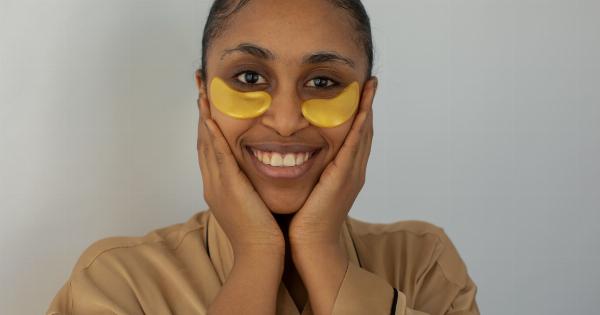Eye barley, also known as a stye or hordeolum, is a common eye condition that affects people of all ages. It appears as a small bump on the eyelid and can be painful and swollen.
Eye barley is usually caused by a bacterial infection in the oil glands of the eyelids. In most cases, it goes away on its own within a few days or weeks without any treatment. However, there are certain measures you can take to alleviate the symptoms and prevent the recurrence of eye barley.
Symptoms of Eye Barley
The symptoms of eye barley may vary from person to person. Some of the most common symptoms include:.
- Redness and swelling of the eyelid
- A small, painful bump on the eyelid
- Tenderness or soreness of the affected area
- A sensation of something in the eye
- Watery eyes
- Blurred vision (in rare cases)
Causes of Eye Barley
Eye barley is primarily caused by a bacterial infection in the oil glands of the eyelids. The bacteria responsible for this infection is often Staphylococcus aureus, which is commonly found on the skin and in the nose.
Other potential causes of eye barley include:.
- Poor eyelid hygiene
- Excessive rubbing of the eyes
- Using expired or contaminated eye makeup
- Sharing eye cosmetics or tools
- Having certain skin conditions, such as acne or rosacea
- Weakened immune system
- Stress or fatigue
Treatment Options
In most cases, eye barley does not require any specific treatment and goes away on its own within a few days or weeks. However, there are several remedies and lifestyle changes that can help alleviate the symptoms and speed up the healing process:.
1. Warm Compress
Applying a warm compress to the affected eyelid can help reduce swelling and relieve discomfort. Soak a clean cloth in warm water and gently place it on your closed eyelid for about 10 to 15 minutes, a few times a day.
Make sure the cloth is not too hot to avoid injury.
2. Maintain Good Eyelid Hygiene
Keeping your eyelids clean is crucial in preventing further infections and reducing the risk of recurrence. Use a mild cleanser or baby shampoo diluted with warm water to clean your eyelids daily.
Gently rub the mixture on your closed eyelids using your fingertips and rinse thoroughly with clean water.
3. Avoid Eye Makeup
While you have an eye barley, it is best to avoid wearing eye makeup to prevent further irritation and bacterial contamination. Using contaminated eye makeup or sharing it with others can worsen the condition or lead to recurrence.
Additionally, make sure to replace your eye makeup regularly to avoid using expired products.
4. Don’t Touch or Squeeze
Resist the temptation to touch, squeeze, or pop the eye barley. It can further aggravate the infection and delay the healing process.
If the bump persists or becomes increasingly painful, consult an eye specialist who can advise on the appropriate treatment options.
5. Over-the-Counter Pain Relievers
If you are experiencing pain or discomfort, you can take over-the-counter pain relievers such as ibuprofen or acetaminophen. Always follow the recommended dosage instructions and consult a healthcare professional if you have any concerns.
6. Antibiotic Ointments
In some cases, your doctor may prescribe antibiotic ointments or eye drops to help clear the infection and prevent further complications. Follow your doctor’s instructions carefully and complete the full course of treatment.
7. Surgery (In Rare Cases)
In rare cases where a stye does not resolve with other treatments or causes persistent discomfort, your doctor may recommend a minor surgical procedure to drain the stye.
This procedure involves making a small incision to release the pus and relieve the pressure.
Preventing Eye Barley
While it may not be possible to completely prevent eye barley, there are measures you can take to reduce the risk of developing this condition:.
1. Practice Good Eyelid Hygiene
Regularly clean your eyelids with a mild cleanser or baby shampoo diluted with warm water. Gently scrub your closed eyelids to remove any dirt, debris, or excess oils. Rinse thoroughly and pat dry with a clean towel.
2. Avoid Rubbing Your Eyes
Refrain from rubbing or touching your eyes, as this can introduce bacteria and irritants onto the eyelids and increase the risk of infections.
If your eyes feel itchy or irritated, try using artificial tears or gently dab your closed eyelids with a clean, wet cloth.
3. Replace Eye Makeup Regularly
Old or contaminated eye makeup can introduce bacteria into your eyes and increase the likelihood of developing eye barley.
Replace your mascara, eyeliner, and other eye cosmetics every three to six months or immediately if you notice any changes in texture, smell, or color.
4. Avoid Sharing Eye Cosmetics
Sharing eye makeup, brushes, or tools can also spread bacteria and increase the risk of eye infections. It is best to avoid sharing these items with others, even if they appear to be clean.
5. Wash Your Hands
Proper hand hygiene is essential to prevent the transmission of bacteria to your eyes. Always wash your hands thoroughly before touching your eyes or applying any eye medications or cosmetics.
When to See a Doctor
In most cases, eye barley does not require medical treatment and can be managed at home with the remedies mentioned above. However, it is essential to consult a doctor if:.
- The bump on the eyelid becomes increasingly painful or does not improve within a few days.
- Your vision becomes blurry or impaired.
- You experience severe eye pain or sensitivity to light.
- The redness and swelling extend beyond the eyelid or affect the entire eye.
- You develop a fever or experience flu-like symptoms.
- You have a history of recurring eye barleys or other eye infections.
A healthcare professional can accurately diagnose your condition, prescribe appropriate medications if necessary, and provide further guidance on managing and preventing future episodes of eye barley.
Conclusion
Eye barley, or stye, is a common eye condition characterized by a small, painful bump on the eyelid that is often caused by a bacterial infection.
While it usually resolves on its own within a few days or weeks, there are home remedies and preventive measures that can alleviate symptoms and reduce the likelihood of recurrence. Maintaining good eyelid hygiene, avoiding eye makeup, and practicing hand hygiene can help prevent eye barley.
If you experience persistent symptoms or develop severe complications, it is important to consult a healthcare professional for proper diagnosis and treatment.




























